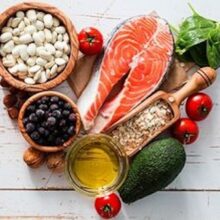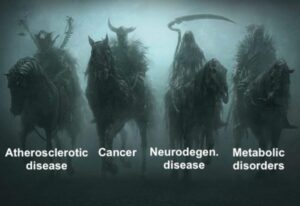How the Mediterranean Diet Beats the Four Horsemen: Prerequisites for Longevity, Part 2

The Mediterranean diet beats the “Four Horsemen of Chronic Disease” via a plant-dominant diet that features phytonutrients, fiber, fermented foods and less meat consumption. Devote yourself to it and keep yourself disease-free!
When I say that the Mediterranean Diet beats the “Four Horsemen”, I assert that a plant-dominant diet can help you prevent suffering and dying from the four leading causes of death of those living in the developed world, which are:
- Atherosclerotic disease
- Cancer
- Neurodegenerative disease
- Metabolic disorders
These four “Horsemen”, a takeoff from the biblical Four Horsemen of the Apocalypse, must be confronted before one or more of them take your life. That’s why doing so is among the “prerequisites for longevity”, and is hereby addressed in Part 2 of this four-part series.
life. That’s why doing so is among the “prerequisites for longevity”, and is hereby addressed in Part 2 of this four-part series.
Part 1 is the Four Exercise Prerequisites of Longevity;
Part 2 you’re reading now;
Part 3 will be about detoxification and hormones; and
Part 4 will be about mindset, sleep and intimacy.
This post will examine:
- What’s the Mediterranean Diet and why it protects against the Four Horsemen
- Foods in the Med Diet that beat the Four Horsemen
- Med Diet recipes
- Your takeaway
Let’s dig in…
The term “Four Horsemen of Chronic Disease” often refers to:
- Atherosclerotic disease: Encompasses conditions like heart disease and stroke, caused by plaque buildup in arteries.
- Cancer: Uncontrolled cell growth with the potential to harm healthy tissues.
- Neurodegenerative disease: A group of conditions like Alzheimer’s and Parkinson’s, marked by progressive brain cell degeneration.
- Metabolic disease: Includes insulin resistance, fatty liver disease, and type 2 diabetes, affecting how the body processes blood sugar.
Heart disease, cancer, stroke, neurodegenerative diseases and metabolic diseases are among the top killers in the USA, Canada and Europe [1][2][3][4][5].
If you want to do a deep dive into these specific chronic diseases, read my post, The Four Horsemen of Disease: The Impact of Aging Hallmarks and Signaling Dysfunction.
This post explores how your dietary choices significantly impact these diseases, serving as both a potent weapon and a potential shield. Let’s explore how specific foods, nutrients and supplements can help prevent you from suffering from one of these illnesses, or ameliorating their impact upon your health.
What’s the Mediterranean Diet and Why It Protect Against the Four Horsemen
The Mediterranean Diet is not a strictly defined set of foods. Depending on the who and where this diet is embraced in the world, different foods can be dominant. I gave some examples of this in my post, The Blue Zone Diet Will Transform You. The “Blue Zone Diet” refers to alterations that the longest-lived people in the world — denizens of the Blue Zones — make to what is fundamentally a Mediterranean Diet, which is a plant-dominant diet.
“Plant-based” does not mean “no meat”, but rather that plant food is the focus. In all of the Blue Zones, most of the diet consists of legumes (beans, peas, lentils and chickpeas), greens, whole grains and nuts, but the mix of these foods vary by Blue Zone.
For instance, note the varying amounts of food groups that constitute these Blue Zones:
- Okinawa, Japan: 67% of their diet is from sweet potatoes; 12% rice; 9% vegetables; 2% meat and fish.
- Loma Linda, California: 33% vegetables; 27% fruits; 12% legumes; 4% meat.
- Sardinia, Italy: 47% whole grains, 26% dairy, 12% vegetables; 5% meat and fish.
- Ikaria, Greece: 20% other vegetables; 17% greens; 16% fruits; 11% legumes; 5% meat.
- Nicoya Peninsula, Costa Rica: 26% whole grains; 24% dairy; 14% vegetables; 9% fruits; 7% legumes; 5% meat and fish.
Obviously, the people inhabiting these different Blue Zones eat from a different composition of foods, but what they have in common are:
- Most of their calories come from plant food.
- Few of their calories come from meat.
- The food is rich in fiber.
- Much of the food is rich in phytochemicals.
- Some food is fermented.
It turns out that these attributes of their diet are also common in the Mediterranean Diet and are protective against chronic disease. This diet boasts a potent synergy of components, each contributing to its disease-fighting prowess against the Four Horsemen: atherosclerosis, cancer, neurodegeneration and metabolic disease. Let’s delve into the specific elements that are particularly potent.
Phytonutrients from plant food
- Atherosclerosis & Antioxidant Army: Fruits, vegetables, and olive oil in the Mediterranean diet are teeming with colorful phytonutrients like carotenoids, flavonoids, and phenolic acids. These potent antioxidants combat oxidative stress and inflammation, two key drivers of atherosclerosis. A meta-analysis in the American Journal of Cardiology demonstrated that higher intakes of fruits and vegetables are associated with a lower risk of coronary heart disease [6] .
- Cancer-Quenching Cavalry: Phytonutrients exhibit anti-proliferative and pro-apoptotic properties (aka apoptosis, programmed cell death), potentially hindering cancer cell growth and survival. Research studies highlight the potential of dietary flavonoids in cancer prevention and therapy [7].
- Neurodegeneration & Cognitive Champions: Phytonutrients like flavonoids and curcumin in the Mediterranean diet may protect against cognitive decline and neurodegenerative diseases. Studies like this one in the journal of Molecular Science suggest that flavonoid intake may be associated with a reduced risk of Alzheimer’s and other neurodegenerative diseases [8].
- Metabolic Militia: Phytonutrients in the Mediterranean diet have anti-inflammatory and insulin-sensitizing properties, potentially aiding in metabolic health. A review in the journal Food Frontiers highlight the potential of phenolic acids in promoting metabolic health and preventing diseases like type 2 diabetes [9].
Meat and longevity
This is a polarizing subject. People who eat and like meat regularly don’t want to be told that it’s unhealthy, or that the planet can not continue to support meat production on the scale required to feed the world’s current appetite for it. So, my suggestion to those devoted to meat is simply to eat less of it.
Why?
In the following seven-minute video, How Much Does Meat Affect Longevity, Dr. Michael Greger walks you through the evidence.
Click here for the transcript
According to the Global Burden of Disease Study, diets high in processed meat, like bacon, ham, hot dogs, lunch meat, and sausage, may kill off more than 100,000 people every year––mostly due to heart disease, but also cancer and diabetes, resulting in millions of healthy years of life lost every year around the world. And it doesn’t take much. The Union of Concerned Scientists estimated that if Americans could cut down to an ounce a week, thousands of annual cancer deaths could be averted. But that’s on a population scale. How can we better understand our individual risk?
Though the NutriRECS panel in the Annals of Internal Medicine meat papers I’ve done the last few videos about discarded their own findings, using their numbers, a reduction in red and processed meat consumption is associated with a 13 percent lower risk of premature death. What exactly does that mean? What does a 13 percent increased risk of death mean? To get a better handle on it, let me introduce the concept of microlives.
Acute risks, such as riding a motorbike or going skydiving, may result in an accident. A good way to compare such risks is with a unit known as a micromort, defined as a one-in-a-million chance of sudden death. I did a really fascinating video about it recently. “However many risks we take don’t kill you straight away: think of all the lifestyle frailties we get warned about, such as smoking, drinking, eating badly, not exercising, and so on. The microlife aims to make all these chronic risks comparable by showing how much life we lose on average when we’re exposed to them.” A microlife is defined as 30 minutes of your life expectancy.
Why is that? Well, someone in their 20s, a 22-year old man or a 26-year old woman, may have, on average, about 57 years left. That’s about 20,000 days, or 500,000 hours, or 1 million half hours. Aha! So, that is how they define a microlife, a reduction of one of the million half hours we may have left. Here are some things that would, on average, cost a 30-year-old man one microlife. Smoking two cigarettes, drinking two pints of beer, or every day they live 11 pounds overweight. See how helpful this can be in terms of comparing risks. So, drinking a pint of strong beer cuts your life expectancy short as much as smoking one cigarette. If it’s unthinkable to you to have so little respect for your own health that you’d light up twice a day, maybe one cigarette in the morning and one at night, then it should be just as unthinkable being 11 pounds overweight.
Alternatively, you can compare life-extending behaviors. For example, eating at least five servings of fruits and veggies a day may add an average of four years onto your lifespan for men, and three years for women. That’s up to twice as beneficial as exercising every day. But check it out. Exercise for 20 minutes, and you add an hour to your life––two microlives. So, for all those who say they don’t have time to exercise, it’s like a three-to-one return on investment. Give 20 minutes of your life to get 60 minutes of life. Beyond that, there’s a bit of diminishing returns, but exercise an hour a day, and get back more time than you put in.
Okay, so what about the meat? Each burger is associated with the loss of a microlife.
So, it’s as if each burger were taking 30 minutes off your life. So, lifespan-wise, one burger appears to equal two cigarettes. If it wouldn’t occur to you to light up at lunch, maybe you should choose the bean burrito instead.
And processed meat is even worse. There are a couple of equivalent ways you could say it. Imagine two people who are identical in every way, except that one eats around 50 grams of processed meat a day, which is like one large sausage or hot dog, or a few strips of bacon, and the other eats none. Eating that single serving of processed meat every day is expected to take around two years off the length of your life. Two years less with your loved ones, your grandkids, your spouse, two more years of mourning. Or you could think about it on a day-to-day basis. Eating a baloney or ham sandwich every day, just two slices of deli meat, is expected to take around one hour off your life each day. If you don’t think there are ever enough hours in the day, you may have effectively one less, depending on what you pack for lunch. Alternatively, you could think about it in terms of “effective age.” Eating 50 grams of processed meat a day is expected to add around two years onto your “effective age,” meaning basically give you the annual chance of dying of someone two years older.
In summary, wrote the chair of Nutrition at Harvard and colleagues, the NutriRECS meat recommendations suffer from important methodological limitations, and involve misinterpretations of nutritional evidence. “To improve human and planetary health [as a side-bonus], dietary guidelines should continue to emphasize dietary patterns low in red and processed meats and high in minimally processed plant foods such as fruits and vegetables, whole grains, nuts, and legumes [(beans, split peas, chickpeas, and lentils)].”
Let me end with a quote from Dr. Dean Ornish about the Annals meat papers that suggested people should continue to eat meat with abandon. His Lifestyle Heart Trial was one of the many studies the meat panel ignored. It showed that a plant-based diet and lifestyle program could reverse the progression of even severe coronary heart disease, the #1 killer of men and women. The control group actually made modest reductions in meat comparable to those in the Annals review and showed continued worsening of their atherosclerosis. “I take solace,” Ornish said, “in knowing that the light drives out the darkness. But, these days, the light has to be very bright indeed. Caveat emptor. Don’t be fooled. Your life may depend on it.”
Fiber for lower cholesterol and blood sugar
- Shield against Atherosclerosis: A systematic review and meta-analysis on randomized clinical trials published in the journal Frontiers in Nutrition confirmed that the supplementation of viscous soluble dietary fiber has potential benefits for the control of blood glucose and lipids in patients with type 2 diabetes. The recommended supplemental dose is from 8.3 g to 10.2 grams/day [10].
Click here for examples of viscous soluble dietary fiber
Sticky soluble dietary fiber, also known as viscous fiber, plays a crucial role in numerous health benefits, from digestive health to blood sugar control. Here are some examples of delicious and nutritious foods packed with this beneficial fiber:
Fruits:
- Pears: Boasting a significant amount of pectin, a major sticky soluble fiber, pears promote satiety and slow down sugar absorption.
- Apples: With both pectin and hemicellulose, apples contribute to gut health, cholesterol reduction, and blood sugar control.
- Citrus fruits: Oranges, grapefruits, and grapefruits offer pectin and other soluble fibers, aiding in digestion and lowering cholesterol levels.
- Berries: Blueberries, raspberries, and strawberries contain soluble fiber along with various antioxidants, supporting gut health and reducing inflammation.
Vegetables:
- Okra: A powerful source of pectin and gumbo, okra thickens liquids and promotes digestive health.
- Brussels sprouts: These cruciferous vegetables offer pectin and other viscous fibers, contributing to cholesterol reduction and gut health.
- Sweet potatoes: With pectin and resistant starch, sweet potatoes slow down digestion, stabilize blood sugar levels, and promote bowel regularity.
- Broccoli: This powerhouse vegetable contains soluble fiber, vitamin C, and other nutrients, benefiting gut health and overall well-being.
Legumes and Grains:
- Oats: Rich in beta-glucan, a potent soluble fiber, oats lower cholesterol, keep you feeling full, and help regulate blood sugar.
- Barley: Containing beta-glucan and arabinoxylans, barley promotes gut health, reduces cholesterol, and aids in blood sugar control.
- Beans and lentils: Packed with soluble fiber, these legumes contribute to satiety, improve digestion, and manage blood sugar levels.
- Chia seeds: These tiny seeds are brimming with soluble fiber, including alpha-linolenic acid, a healthy omega-3 fatty acid, providing gut health benefits and blood sugar regulation.
Bonus:
- Psyllium: This soluble fiber supplement, often used in bulk laxatives, effectively promotes digestive health and cholesterol reduction.
Remember, incorporating a variety of these fiber-rich foods into your diet can significantly enhance your health and well-being. So, get creative, add these delicious options to your meals and snacks, and reap the benefits of sticky soluble dietary fiber!
- Cancer-Fighting Champion: Fiber promotes healthy gut bacteria that produce beneficial short-chain fatty acids, potentially reducing the risk of colon cancer. Research studies find evidence that high fiber intakes, particularly from cereals or grains and fruit, are associated with a reduced risk of incident colorectal adenoma and cancer [11]. (colorectal adenoma, also known as a colonic polyp, is a non-cancerous growth that develops on the inner lining of the colon or rectum, and can develop into colorectal cancer if not removed.)
- Neuroprotective Ally: Fiber, particularly prebiotics, nourishes gut bacteria, influencing neurotransmitter production and potentially supporting cognitive function. Certain gut bacteria strains may interact with the brain via the gut-brain axis, influencing cognitive health [12][13].
- Metabolic Maestro: Fiber slows down sugar absorption, improving insulin sensitivity and blood sugar control, crucial for preventing type 2 diabetes, says the CDC [14]. A meta-analysis of 15 studies published in the JABFM highlight the beneficial effects of dietary fiber on HbA1c levels in individuals with type 2 diabetes [15]
Fermentation
Fermented foods were not specifically addressed above in the discussion of the Mediterranean diet, but they are a valuable component of any diet that seeks to improve healthspan due to their beneficial impact on the gut microbiome.
- Atherosclerosis & Microbiome Magic: Fermented foods like yogurt, kimchi, and sauerkraut harbor beneficial probiotics that improve gut health. Studies suggest that probiotics may lower LDL cholesterol and improve blood pressure, contributing to cardiovascular health [16].
- Cancer Ally: Probiotics may modulate the immune system and influence the gut microbiome, potentially impacting cancer development. Research suggests that certain probiotic strains may have anti-tumor properties [17].
- Brain Booster: Probiotics may influence the gut-brain axis, potentially impacting cognitive function and neurodegenerative diseases. Probiotics may improve cognitive function and memory in individuals with mild cognitive impairment [18].
At this point, you’ve gotten a picture of how some of the basic components of the Mediterranean Diet — such the abundant consumption of phytonutrients, fiber and fermented foods, along with deprioritizing meat — can protect you from becoming afflicted with any of the Four Horsemen of disease.
Now, I want to explore with you what specific foods to embrace that can help prevent or ameliorate the deleterious impact of the four chronic diseases we’ve covered.
These Foods In the Mediterranean Diet Beat the Four Horsemen
You may know which of the four diseases you have or are prone to get. In either case, you can scroll down and quickly see what foods you can begin to prioritize in your diet. I’ve also included what tests you can take to evaluate your status relative to atherosclerotic disease, cancer, neurodegenerative disease and metabolic disease.
Atherosclerotic Disease
Foods to Embrace:
- High-fiber foods: Fruits, vegetables, whole grains, and legumes help lower cholesterol and reduce inflammation.
- Fatty fish: Rich in omega-3 fatty acids, which decrease bad cholesterol and improve blood vessel function.
- Nuts and seeds: Rich in protein, fiber, and healthy fats, they lower inflammation and improve blood vessel health.
Nutrients to Boost:
- Potassium: Found in fruits and vegetables, it helps regulate blood pressure and counteracts the negative effects of sodium.
- Magnesium: Abundant in nuts, seeds, and leafy greens, it improves endothelial function and blood pressure.
Blood Tests:
- Lipoprotein profile: Measures various cholesterol types like LDL (bad) and HDL (good).
- C-reactive protein (CRP): Indicates inflammation, a risk factor for cardiovascular disease.
Sodium’s Impact:
- High sodium intake elevates blood pressure, increasing heart disease risk. Aim for less than 2,300mg/day, ideally 1,500mg for those with hypertension.
Cancer
Foods to Embrace:
- Cruciferous vegetables: Broccoli, kale, and cabbage contain sulforaphane, a compound with anti-cancer properties.
- Berries: Rich in antioxidants like anthocyanins, which protect cells from damage.
- Turmeric and ginger: Contain curcumin and gingerol, respectively, with anti-inflammatory and anti-cancer effects.
Nutrients to Boost:
- Vitamin C: Found in citrus fruits and bell peppers, it protects cells from free radical damage.
- Vitamin E: Abundant in nuts, seeds, and avocados, it has antioxidant and anti-inflammatory properties.
Blood Tests:
- Tumor markers: Can indicate the presence of certain cancers, though not definitive.
- Cancer screening tests: Based on age and risk factors, like colonoscopies or mammograms.
Neurodegenerative Disease
Foods to Embrace:
- Fatty fish: Provide DHA, an omega-3 fatty acid crucial for brain health.
- Berries and dark leafy greens: Rich in antioxidants and flavonoids, which protect brain cells.
- Nuts and seeds: Contain vitamin E and other nutrients beneficial for cognitive function.
Nutrients to Boost:
- Vitamin D: Promotes brain cell health and may reduce Alzheimer’s risk.
- Curcumin: Has anti-inflammatory and neuroprotective properties.
Blood Tests:
- Beta-amyloid and tau proteins: Potential markers for Alzheimer’s, but interpretation is complex.
- Cognitive function tests: Assess memory, reasoning, and other cognitive abilities.
Metabolic Disease
Foods to Embrace:
- Low-glycemic foods: Fruits, vegetables, and whole grains cause slower blood sugar rise, improving insulin sensitivity.
- Healthy fats: Avocados, fatty fish, and nuts provide satiety and improve insulin sensitivity.
- High-protein foods: Legumes, nuts, and lean meats help regulate blood sugar and appetite.
Nutrients to Boost:
- Fiber: Slows down sugar absorption and improves gut health.
- Magnesium: Enhances insulin sensitivity and regulates blood sugar.
Blood Tests:
- Fasting glucose and insulin: Evaluate how your body processes sugar.
- HbA1c: Provides a longer-term view of blood sugar control.
Mediterranean Diet Recipes
YouTube has hundreds if not thousands of videos that can show you how to make the many, many Mediterranean Diet-based meals that can fuel your resistance to chronic disease and prolong your healthspan.
Blue Zone recipes
The Blue Zone website lists hundreds of recipes that take 30 minutes or less to make. The search tool can quickly help you find what you want. A screenshot example:
If you want more help, consider the Blue Zone meal planner. For $14/month, you’ll get customized meal plans delivered to you.
Nutritionfacts recipes
Nutritionfacts.org run by Dr. Michael Greger, whose video you might have watched above, also has hundreds of plant-focused recipes you can sort through or find via their search tool.
Here’s a screenshot:
allrecipes
allrecipes has a dazzling number of recipes for any meal you can think of. Use its search tool to give you a list of a food category or a specific meal. I typed in “vegan” and was immediately shown many pages of recipes.
Here’s a screenshot of a few:
Your Takeaway
Remember these three things:
- The “Four Horsemen of Chronic Disease” represent the top killers of people in the developed world. Typically, we don’t die from old age, but from one of these: atherosclerosis, cancer, neurodegeneration and metabolic disease.
- The type of food consumed within the Mediterranean Diet can help prevent or reduce the ill effects of the “Horsemen”. If you’re not eating this way already, gradually add plant foods to your diet so that you can get the phytonutrients, fiber and fermented foods into your body on a regular basis, while at the same time limiting your meat consumption.
- There’s plenty of help available to you — just consult the three recipe resources I linked to above, or take a stroll through YouTube’s Mediterranean Diet advocates.
If you know someone that’s wrestling with any of the Horsemen, send them this post.
Go to:
Last Updated on February 7, 2024 by Joe Garma






